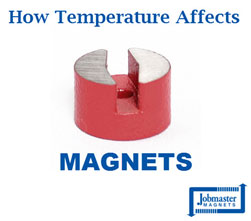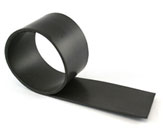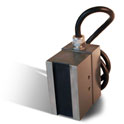Magnetism and Temperature Basics

In general, magnets perform better in cold environments than in hot environments. Extreme heat typically leads to a loss of magnetic strength. If the ambient temperature goes above a certain point, called the maximum operating temperature, the magnet may permanently lose some of its strength. If it is further heated, it will lose more strength, and if it is heated to its Curie temperature, it will effectively lose all magnetic strength. Maximum operating temperature and Curie temperature are determined by the material a particular magnet is made of and the size and shape of the magnet.
Using magnets at temperatures below room temperature is not an issue.
Temperature and Common Types of Magnets
Rare-Earth Magnets
 Typically made of neodymium or samarium cobalt, rare-earth magnets are prized for their strength and ability to perform in relatively harsh conditions. While neodymium is actually the stronger of the two types, it is the least able to withstand extreme heat. Neodymium magnets typically have maximum operating temperatures between 125 and 150 degrees Celsius and Curie temperatures between 310 and 400 degrees Celsius.
Typically made of neodymium or samarium cobalt, rare-earth magnets are prized for their strength and ability to perform in relatively harsh conditions. While neodymium is actually the stronger of the two types, it is the least able to withstand extreme heat. Neodymium magnets typically have maximum operating temperatures between 125 and 150 degrees Celsius and Curie temperatures between 310 and 400 degrees Celsius.
For extreme conditions, samarium-cobalt magnets are better than neodymium magnets. Samarium-cobalt magnets typically have maximum operating temperatures between 250 and 500 degrees Celsius and Curie temperatures between 700 and 800 degrees Celsius.
Alnico Magnets
Alnico magnets are a good choice for use in extremely hot environments. The maximum operating temperature of an Alnico magnet is usually around 525 degrees Celsius, and the Curie temperature is approximately 800 degrees Celsius.
Flexible Magnets
 These magnets have properties similar to those of ceramic magnets because flexible magnets are a laminated mixture of ceramic powder and a flexible binder. Flexible magnets are, however, less reliable at high temperatures than ceramic magnets because the binding material becomes unstable at approximately 100 degrees Celsius.
These magnets have properties similar to those of ceramic magnets because flexible magnets are a laminated mixture of ceramic powder and a flexible binder. Flexible magnets are, however, less reliable at high temperatures than ceramic magnets because the binding material becomes unstable at approximately 100 degrees Celsius.
Ceramic Magnets
For some high-temperature applications, ceramic magnets, also called hard ferrite magnets, offer great value and performance. They have a maximum operating temperature of approximately 250 degrees Celsius or higher and a Curie temperature of about 450 degrees Celsius. These magnets, however, are not recommended for use in cryogenic applications. They are less tolerant of cold temperatures than other types of magnets and show some permanent loss of strength at temperatures below -60 degrees Celsius.
Electromagnets
 Unlike the permanent magnets discussed above, electromagnets are temporary magnets. Like the other magnets, however, ambient temperature affects their performance. Electromagnets usually work best at room temperature. Extreme heat causes degradation of the wiring and potting compounds.
Unlike the permanent magnets discussed above, electromagnets are temporary magnets. Like the other magnets, however, ambient temperature affects their performance. Electromagnets usually work best at room temperature. Extreme heat causes degradation of the wiring and potting compounds.













